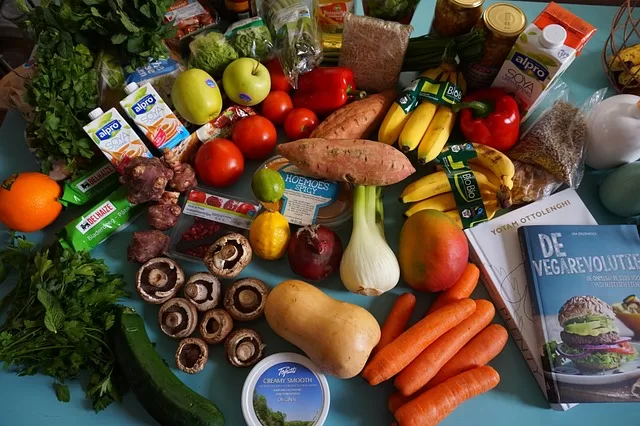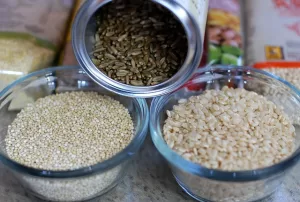This post contains affiliate links. See our Affiliate Disclosure Statement page for more details.
Table of Contents
6 Benefits of Dog Food With Grain
Dog food with grain can provide a number of benefits to help keep your Boxer dog healthy
However, there are potential drawbacks that must be taken into consideration when feeding your Boxer dog food with grain.
This article examines the benefits, drawbacks, and types of grains used in dog food. So let’s begin with the benefits.
6 Benefits of Dog Food with Grain
- Source of Carbohydrates
- Fiber Content
- Nutrition Profile
- Cost Effective
- Allergy Management
- Palatability
It is important to note that not all grains provide equal benefits because the quality and type of grain used can vary among manufacturers.
It’s crucial to consider the specific needs and health requirements of your dog.
Consult with your veterinarian, and choose a high-quality dog food that meets your dog’s nutritional needs, including the appropriate amount and type of grains, if included.
Now let’s look at each of the 6 benefits in more detail.
Sources of Carbohydrates

Why are Carbohydrates Important
- Grains are a good source of carbohydrates, which are an important source of energy for dogs.
- Dogs require carbohydrates in their diet to fuel their daily activities and maintain optimal health.
Dog Food with Grain – Benefits of Carbohydrates
Carbohydrates play several important roles in a dog’s diet and provide specific benefits, including
- Energy Source
- Carbohydrates are an important source of energy for dogs.
- They are converted into glucose, which is used by cells as a primary source of energy.
- Dogs require energy for their daily activities, exercise, and overall metabolic functions, and carbohydrates provide a readily available source of energy.
- Fiber for Digestive Health
- Carbohydrates can be a source of dietary fiber, which is essential for maintaining healthy digestion in dogs.
- Fiber promotes regular bowel movements, prevents constipation, and supports the growth of beneficial gut bacteria.
- It also helps to regulate blood sugar levels and promotes a feeling of fullness, which can be beneficial for weight management in dogs.
- Nutrient Absorption
- Some carbohydrates, such as oligosaccharides (sugars in fruits and vegetables that are not easily broken down by the GI tract), can act as prebiotics, which promotes the growth of beneficial bacteria in the gut.
- Source: What are Oligosaccharides, All You Need to Know, Healthline.com, Petre and Kubala, April 2022.
- These beneficial bacteria help in the absorption of essential nutrients from the food, such as vitamins and minerals, which are important for overall health and well-being in dogs.
- Weight Management
- Carbohydrates can play a role in weight management in dogs.
- High-fiber carbohydrates, such as whole grains and vegetables, can help dogs feel fuller for longer periods of time, reducing their overall calorie intake and promoting healthy weight management.
- Carbohydrates can be used strategically in specialized weight management diets formulated for overweight or obese dogs to control their caloric intake and support weight loss.
- Palatability
- Many commercial dog foods contain carbohydrates, such as rice, potatoes, and grains.
- Can enhance the palatability and texture of the food, making it more appealing to dogs.
- This can help encourage dogs to eat their meals and maintain a healthy appetite.
- Training Treats
- Carbohydrates, such as small amounts of fruits or vegetables, can be used as healthy training treats for dogs.
- They can provide a low-calorie option for rewarding good behavior during training sessions, without adding excessive calories to the dog’s diet
For a dog food with healthy carbohydrates for your Boxer, we recommend Turkey & Whole Wheat Macaroni Recipe from Just Food For Dogs.
It’s important to note that the specific carbohydrate needs of dogs may vary depending on factors such as
- Age
- SIze
- Breed
- Activity Level
- Health Condition
Consulting with a veterinarian or a qualified veterinary nutritionist can help determine the appropriate carbohydrate levels and sources for a dog’s individual dietary needs
For more information on Carbohydrates read our article Boxer Dog Diet – 5 Essential Nutrients to Keep Your Dog Healthy and Active
Dog Food with Grain – Fiber Content

- Many grains are high in dietary fiber, which can aid in digestion and promote healthy gut function in dogs.
- Fiber can also help regulate blood sugar levels and promote satiety, which can be beneficial for dogs that need weight management or have certain health conditions such as diabetes.
Table comparing typical Grains used in dog food with their Percentages and fiber content
| Grain Type | Typical Percentage in Dog Food Formulations | Typical Fiber Content |
|---|---|---|
| Rice | 30-50% | 1-3% |
| Wheat | 20-40% | 2-6% |
| Corn | 20-40% | 1-3% |
| Oats | 10-30% | 3-6% |
| Barley | 10-30% | 2-4% |
| Sorghum | 5-20% | 2-4% |
| Millet | 5-15% | 1-4% |
| Quinoa | 1-10% | 2-5% |
| Rye | 1-10% | 3-6% |
| Buckwheat | 1-10% | 2-4% |
For a high-fiber dog food, we recommend Ollie Turkey and Blueberries dinner. It uses 100% Human Grade Ingredients and it contains high-fiber ingredients including Blueberries, Kale, Carrots, and Pumpkin
Dog Food with Grain – Sources of Fiber
Fiber is an important component of a dog’s diet and can be found in various types, including
- Soluble
- Soluble fiber dissolves in water and forms a gel-like substance in the intestines, which can help regulate digestion and promote healthy bowel movements.
- Insoluble
- Insoluble fiber does not dissolve in water.
- When insoluble fiber is ingested it moves through the digestive tract without being broken down or digested.
- Insoluble fiber provides bulk to the stool helping it move through the colon.
Both types of fiber can be beneficial for dogs and are commonly used in dog foods that contain grains.
When it comes to dog foods with grains, different grains can provide varying amounts and types of fiber. For example, grains like
- Rice
- Corn
- Wheat
- Oats
are known to contain both soluble and insoluble fiber, although the specific proportions may vary.
Rice and wheat, for instance, tend to be higher in soluble fiber, while oats and corn are often higher in insoluble fiber. Barley and sorghum are other grains that are commonly used in dog food formulations and are good sources of fiber, including both soluble and insoluble types.
Including grains with fiber in a dog’s diet can help promote
- Healthy Digestion
- Regulate Bowel Movements
- Provide Overall Gut Health
However, it’s important to note that the ideal amount and type of fiber for a dog’s diet can vary depending on factors such as the dog’s
- Age
- Breed Size
- Individual Needs
Consulting with a veterinarian or a qualified pet nutritionist can help determine the appropriate amount and type of fiber for a dog’s specific dietary requirements, including soluble and insoluble fiber.
Additionally, when selecting a dog food with grains, it’s important to carefully read and understand the ingredient list and guaranteed analysis to ensure that the fiber content meets the specific needs of your dog.
If your dog has GI issues or diarrhea, we recommend NomNom Probiotic Support GI Targeted for dogs to help your Boxer with their GI issues.
NomNom Probiotic Support GI Targeted for DogsDog Food With Grain – Nutritional Value

Grains can provide essential nutrients such as vitamins, minerals, and antioxidants, which are important for a balanced and complete diet for dogs.
For example, grains like brown rice and quinoa are good sources of B vitamins, while oats are high in fiber and provide a good source of manganese.
While some dogs may have specific dietary requirements that may require a grain-free diet, grains can be a valuable and nutritious component of many dog food formulations.
Dog Foods with Grains provides dogs with the nutrients they need to to be active and healthy.
As always, consulting with your veterinarian is recommended to determine the best nutritional plan for your individual dog’s needs
Dog Food With Grain – Nutrition Table
The table below lists some of the most commonly used grains in dog food with grain along with the corresponding macro and micronutrients.
| Grain | % Carbohydrates | % Fat | % Protein | Vitamins Provided | Minerals Provided |
|---|---|---|---|---|---|
| Rice | 73 | 2.7 | 7.5 | Thiamin (B1), Niacin (B3), Folate (B9), Vitamin D | Calcium, Phosphorus, Magnesium, Selenium |
| Oats | 66 | 7.0 | 17.0 | Thiamin (B1), Niacin (B3), Vitamin B6, Folate (B9), Vitamin E | Calcium, Phosphorus, Magnesium, Iron, Zinc |
| Barley | 78 | 1.3 | 9.3 | Thiamin (B1), Niacin (B3), Vitamin B6, Folate (B9), Vitamin E | Calcium, Phosphorus, Magnesium, Selenium |
| Wheat | 73 | 1.5 | 14.5 | Thiamin (B1), Niacin (B3), Vitamin B6, Folate (B9), Vitamin E | Calcium, Phosphorus, Magnesium, Selenium |
| Corn | 74 | 1.7 | 9.4 | Thiamin (B1), Niacin (B3), Pantothenic Acid (B5), Folate (B9), Vitamin E | Calcium, Phosphorus, Magnesium, Selenium |
| Quinoa | 71 | 6.1 | 14.1 | Thiamin (B1), Riboflavin (B2), Niacin (B3), Vitamin B6, Folate (B9), Vitamin E | Calcium, Phosphorus, Magnesium, Iron, Zinc |
| Millet | 70 | 4.2 | 11.0 | Niacin (B3), Vitamin B6, Folate (B9), Vitamin E | Calcium, Phosphorus, Magnesium, Iron, Zinc |
| Sorghum | 76 | 3.1 | 9.7 | Thiamin (B1), Niacin (B3), Vitamin B6, Folate (B9), Vitamin E | Calcium, Phosphorus, Magnesium, Iron, Zinc |
| Rye | 78 | 1.6 | 10.0 | Thiamin (B1), Niacin (B3), Vitamin B6, Folate (B9), Vitamin E | Calcium, Phosphorus, Magnesium, Selenium |
| Brown rice | 76 | 2.7 | 7.0 | Thiamin (B1), Niacin (B3), Folate (B9), Vitamin D | Calcium, Phosphorus, Magnesium, Selenium |
Note: Nutritional values may vary depending on the specific type of grain and the processing methods used in dog food production. Always consult the ingredient list and guaranteed analysis on the dog food packaging for accurate nutritional information.
For additional information on the nutrition of the 4 major types of diets fed to Boxers, read our article Best Boxer Dog Feeding Guide – Top 4 Diets Compared for Nutrition.
For making nutritious at home for your Boxer dog, we recommend Just Food For Dogs Do It Yourself Homemade Turkey and Whole Wheat Macaroni kits. Other flavors kits are available as well.
Dog Food With Grain – Cost-Effective Benefit
Grains can be a cost-effective source of nutrition in dog food compared to other ingredients
- Meat
- Animal Based Protein
can be more expensive.
Including grains in dog food formulations can help keep the cost of manufacturing dog food more affordable.
For more information on the cost-effective benefits of dog food with grain read our article Wet vs. Dry – 5 Best Reasons Why Wet Dog Food Outshines Kibble for Health & Nutrition
Dog Food With Grain – Allergy Management

While some dogs may have grain allergies or sensitivities, the majority of dogs can tolerate grains in their diet without issue.
In fact, grains can be beneficial for dogs with food allergies to common animal proteins, as they provide an alternative protein and carbohydrate source.
The results of two clinical studies, Food Allergies in Dogs – Canine Review, Journal of Entomology and Zoological Studies, Bhagat, et.al, 2017 and Food Allergies in Dogs, VCA Hospitals, Llera, Barnette and Ward identified the top 6 Food allergies in dogs are:
- Beef
- Dairy Products
- Wheat
- Lamb
- Chicken Egg
- Soy
As you can see from this list 4 of the 6 most commonly seen allergens are animal-based proteins.
It is important to note that Wheat is the second most commonly used grain in dog food with grain. Therefore, if your Boxer has Wheat allergies it is important to read ingredient listings to avoid these products.
For additional information on food allergies in dogs, read our article.
6 Top Food That Lead to Food Allergies in Your Boxer Dog
For allergy relief products for your Boxer dog we recommend PetCareRx. They offer a wide variety of products, quick delivery and great customer service.
Save an Extra 25% OFF Sitewide + Enjoy Free Standard Shipping on orders $48+ only at PetCareRx.com! Use Code: CARE25Palatability
One of the factors to consider when feeding your Boxer dog food with grain is whether will they eat it.
Boxers can sometimes be picky eaters. However, most dogs find a dog food with grain palatable and actually enjoy eating these foods.
So, if you have a picky eater in your house you may want to consider feeding them dog food with grain, provided your veterinarian approves based on your dog’s health status.
Cons of Dog Food With Grain

All products provide benefits but there are also potential drawbacks associated with them as well.
Below are drawbacks or cons associated with dog food with grain.
- Allergies or Sensitivities
- Some dogs may have allergies or sensitivities to grains, which can result in gastrointestinal issues, skin irritations, or other adverse reactions.
- Grain allergies in dogs are relatively uncommon but can occur in certain cases.
- If your dog has a known grain allergy or sensitivity, or if you suspect they may have one, it’s important to avoid grains in their food and opt for grain-free or limited-ingredient dog food options.
- Digestive Issues
- Grains, especially when used in excessive amounts or of poor quality, can be difficult for some dogs to digest.
- Dogs have different digestive capabilities, and certain grains may cause digestive upset, such as gas, bloating, or diarrhea in some dogs.
- This can be more common in dogs with sensitive stomachs or digestive issues.
- In such cases, choosing dog food with easily digestible grains or opting for grain-free options may be beneficial.
- If your Boxer has a sensitive stomach try Just Food For Dogs Venison & Squash recipe which is specially developed for dogs with sensitive stomachs.
- Calorie Density
- Grains can be relatively high in carbohydrates, which can contribute to the overall calorie density of dog food.
- This can be a concern for dogs that are prone to weight gain or that require a low-carb diet due to health conditions such as diabetes or obesity.
- A grain-free or low-carb dog food option may be more appropriate.
- Nutrient Dilution
- Grains can also dilute the overall nutrient density of dog food, as they may displace other nutrient-rich ingredients, such as meat or animal-based proteins.
- This means that the overall nutrient profile of the dog food may be lower, which could be a concern for dogs with specific nutrient requirements or those on a highly specialized diet.
- Quality Considerations
- The quality of grains used in dog food can vary, and some lower-quality grains may be less nutritious or even contaminated with harmful substances, such as mycotoxins or pesticides.
- It’s important to choose a reputable dog food brand that uses high-quality grains and has strict quality control measures in place to ensure the safety and nutritional value of its products.
6 Most Commonly Used Grains in Dog Food with Grain
Dog food with grain can include a variety of different types of grains.
Listed below are the 6 most commonly used grains in dog food with grain.
- Rice
- Both white rice and brown rice are commonly used in dog food.
- Brown rice, in particular, is also a good source of fiber and some essential nutrients.
- For a fresh dog food with Rice that has limited ingredients, we recommend Ollie’s Fresh Lamb with Cranberries Dinner. It also include Kale for Fiber
- Oats
- Oats are another grain that is often used in dog food.
- They are a good source of dietary fiber, which can help promote healthy digestion in dogs.
- They also contain essential nutrients such as manganese and B vitamins.
- Barley
- Barley is a whole grain that is sometimes used in dog food.
- It is a good source of dietary fiber and can also provide some vitamins and minerals.
- Wheat
- Wheat is a common grain used in dog food, although it can be a source of allergies for some dogs.
- Wheat is a source of carbohydrates, protein, and fiber, but it is also a known allergen for certain dogs with wheat sensitivities or allergies.
- Corn
- Corn is another grain that is used in some dog foods.
- It is a source of carbohydrates and can also provide some fiber and essential nutrients.
- However, corn is also a common allergen for dogs with corn sensitivities or allergies.
- Quinoa
- Quinoa is a pseudo-grain that is sometimes used in dog food.
- It is a good source of protein, fiber, and essential nutrients, including amino acids which are important for a balanced diet.
- It’s important to note that the quality and processing of grains can vary, and not all grains are created equal.
- High-quality grains that are properly processed and included in appropriate amounts can provide beneficial nutrition for dogs.
- However, it’s essential to consider your dog’s individual dietary needs, allergies, and sensitivities, and consult with your veterinarian to determine the most appropriate dog food formulation.
The table below compares the advantages and disadvantages of each type of grain used in dog food with grain.
Dog Food with Grain – Advantages and Drawbacks comparison table
| Grain | Quantity Used in Dog Food | Common Uses | Benefits | Drawbacks |
| Rice | Moderate to High | Carbohydrate source, easy to digest | Good source of energy, fiber, and essential nutrients | May not be suitable for dogs with rice allergies or sensitivities |
| Oats | Moderate | Carbohydrate source, source of fiber | Good source of dietary fiber and essential nutrients | May not be suitable for dogs with oat allergies or sensitivities |
| Barley | Moderate | Carbohydrate source, source of fiber | Good source of dietary fiber, vitamins, and minerals | May not be suitable for dogs with barley allergies or sensitivities |
| Wheat | Moderate to High | Carbohydrate source, source of protein | Can provide carbohydrates, protein, and fiber | Common allergen for dogs with wheat sensitivities or allergies |
| Corn | Moderate to High | Carbohydrate source, source of fiber | Can provide carbohydrates, fiber, and some essential nutrients | Common allergen for dogs with corn sensitivities or allergies |
| Quinoa | Low to Moderate | Protein and nutrient source | Good source of protein, fiber, and essential nutrients | Relatively expensive compared to other grains, may not be suitable for dogs with quinoa allergies or sensitivities |
Please note that the suitability and impact of grains in dog food can vary depending on a dog’s individual health and dietary needs.
It’s important to consult with your veterinarian and consider your dog’s specific requirements and potential allergies or sensitivities when choosing a dog food that includes grains.
Summary
In summary, a dog owner may choose to feed their dog a dog food with grains for various reasons, including
- Nutritional Balance
- Digestive Health
- Cost-Effectiveness
- Absence of Grain Allergies or Sensitivities
- Personal Preference
It’s important to consider the specific needs of the dog, consult with a veterinarian, and choose a high-quality dog food that meets the dog’s nutritional requirements for optimal health and well-being.

Discoverboxerdogs.com are Mary and Chris Kustanbauter. We reside in Red Lion, PA with our two Boxers, Duke and Katie, who are both rescue dogs. We have been working with Adopt A Boxer Rescue for the past 17 years and have adopted 5 Boxers from this fine organization. To learn more visit our Home, Boxer Dog Family, and Blogs Pages Visit us on social media on Facebook – Discoverboxerdogs.com, Instagram, and Pinterest


